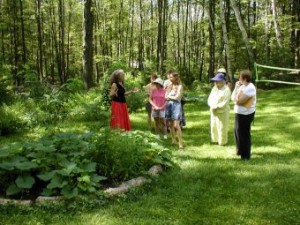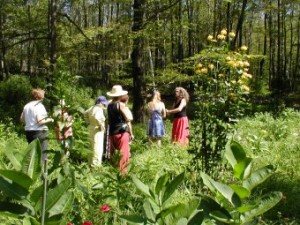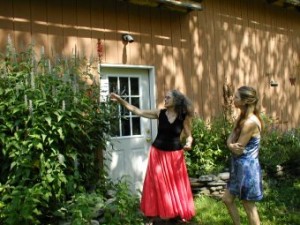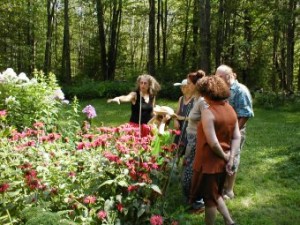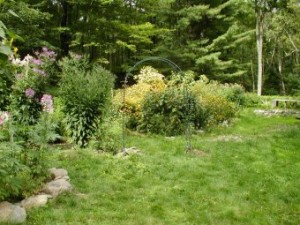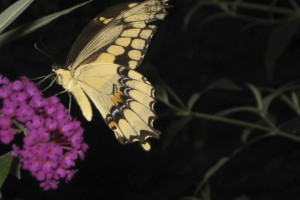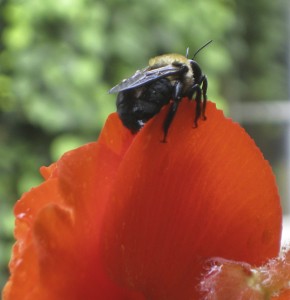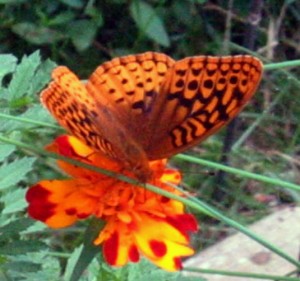
BUTTERFLY/POLLINATOR GARDEN TOURS
Maraleen Manos-Jones offers tours of her Butterfly/Pollinator Gardens in Shokan, New York every summer.:
To see more pictures of the garden tours, click here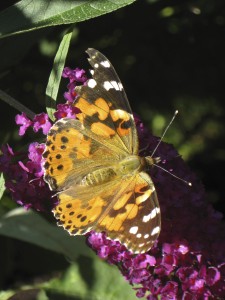
Since we don’t know how far into the summer we will have to socially distance, I have not yet set dates for this summer, 2020, for the garden tours.
Maraleen Manos-Jones, Butterfly Woman, will be your guide as you taste, smell, and stroll through the extensive gardens, take a mindful walk through a labyrinth, adjourn to the art studio, sip iced garden teas, nibble on butterfly cookies, and learn how you can help protect pollinators with an informative and inspiring illustrated talk by Maraleen.
Reservations and directions: 845-657-8073 or email mmjbutterfly@hvc.rr.com
A comment from ten year old Daniel of Rosendale, N.Y. when asked what he thought of the tour in July 2014: “On a score of one to ten, I give it one hundred. I learned so much and want to come back.”
A letter from a lovely woman named Sonya from Palenville in August 2014: “I went on your magical garden tour this weekend and I just wanted to let you know that I enjoyed it so much! You and your wonderful knowledge have inspired me in so many ways! Thank you so much for your openness and generosity in sharing it with everyone. I am excited to plant milkweed again and feel that I can do more myself in my own garden. I will be contacting you for seeds. (yes, she did and got some) And will definitely come back for another garden tour in the future. So glad the universe brought me to your garden path. You are awesome.”
Each and every garden is important. Learn about how you can transform not only your own garden, but help save all our pollinators and learn about The Pollinator Friendly Towns Initiative.
Make reservations early, these events fill up quickly. tel: 845-657-8073 or email mmjbutterfly@hvc.rr.com
Maraleen is also available to give private tours for your group of 10 adults or children. Contact Maraleen for more details.
Maraleen is available as a Butterfly Garden Consultant. Please contact her at 845-657-8073 or mmjbutterfly@hvc.rr.com
Wouldn’t it be grand for all of us, from individuals to schools and community groups, to plant gardens for the butterflies, the birds and the bees? Your region could be known as a Pollinator Friendly Town, an eco-haven for butterflies, bees, birds and all creatures, including humans, living in balance and harmony.
Butterfly gardening not only adds immense beauty, serenity and joy to your life, it is vital in helping to save many species of butterflies, including the monarchs. Butterfly habitats are disappearing at an enormous rate, at least 2.3 million acres a year. In addition to habitat loss, the use of pesticides and herbicides kills caterpillars and butterflies.
The Importance of Butterfly Gardening
Have you heard people say they don’t see as many butterflies as they used to? This is the twelfth summer of my butterfly gardens in Shokan, New York. It is thrilling to see scores of butterflies visiting daily, from little banded hairstreaks, wood nymphs, and skippers to the large great spangled fritillaries, eastern tiger swallowtails, spicebush swallowtails, spring and summer azures, monarchs and more. Invite them for lunch, and they’ll stay for dinner.
As wonderful guests, they bring joy and beauty to your door. I don’t think we want to wait till our native butterflies are on the verge of disappearing before we take simple steps to invite these beautiful creatures into our gardens and our lives.
There are a litany of reasons why butterfly populations have declined, such as pollution of air, soil and water, widespread use of insecticides and herbicides, monoculture and GMO crops, tremendous loss of habitat and global warming . Deer overpopulation also results in loss of herbaceous forest floor plants which many butterflies need for survival. Most of the thirty three million acres of lawns in the U.S. are dead zones, using more poisons per acre than big Ag, which is no sloucher.
Can we actually make a difference if we plant what the butterflies need? You bet we can. Providing habitats for all stages of a butterfly’s life is more than an obscure hobby, it is of vital importance if we don’t want to see them and other wondrous creatures disappear.
There are examples of butterfly species being brought back from the edge of extinction. The people in the town of Wilton, New York made a concerted community-wide effort in the Adirondacks to restore the habitats of the nearly extinct Karner blue butterfly. By massive planting of wild blue lupines, its only host plant, the Karner blue now graces the area each July. Everyone got involved, from school children to community groups to individuals.
Hopefully you have many butterflies already visiting your gardens. Autumn is the time to plant milkweed seeds which have to overwinter to sprout. No matter the season, it is always time to be inspired by butterflies. From spring through autumn we encounter these beautiful creatures. In the winters, their power of transformation informs our dreams and inspires our souls while we plan our gardens to attract them.
There are many reasons for stopping the decline of butterflies: their sheer beauty, their value as pollinators, and planting for local butterflies helps restore native habitat. Butterflies not only pollinate flowers, but also our souls. Witnessing the transformation of caterpillars to butterflies is a continual reminder of our own potential to transform. They have inspired our ancestors for thousands of years in all parts of our planet through myth, art, poetry, music, literature and more than ever in the popular culture. They are symbolic of eternal love, the immortal soul and rebirth.
Butterflies are an ecological symbol, reminding us to take care of our planet, it’s the only one we’ve got. They are the new canaries in the coal mine. If they vanish, it would mean the whole tapestry of life is unraveling beyond repair. If we all gardened with mostly native non-invasive plants, we could make a big difference in keeping our mini-ecosystems vibrant and help not only butterflies, but a myriad of species, thrive and flourish.
Maraleen Manos-Jones has researched the local butterflies in her area, the Northeast, and planted their favorite nectar and host plants. There are about 17,500 species of butterflies worldwide; however, in the Northeast, there are about seventy species. She planted all their favorite nectar and necessary host plants for their caterpillars. She considers it
a hopeful sign that scores of butterflies visit her gardens, sometimes more than a hundred a day.
Here is a letter to editors of Woodstock Times and Daily Freeman from Moira Joyce who attended a garden tour in July 2013:
“I normally do not write letters to newspapers, but I was so impressed by the incredible beauty of a garden tour that I had the honor to attend, I was inspired to share this information. Maraleen Manos Jones had a tour of her incredible butterfly gardens that made me feel that I had walked right into a fantasy world. Her many different types of flowers attract many different butterflies, honeybees and humming birds. There were so many hummingbirds there that I felt like I was at a humming bird racetrack. Maraleen created a medicine wheel with the four directions healing stones that she made out of shells, jewels, stars on a concrete base, with flowers in the center.
Maraleen also made a labyrinth that we walked on that was created to help us focus our intentions to create what we desire in our lives. We then went into her art studio (that her husband, Steve built) and she gave an animated talk on how she became the Butterfly Woman, then enlightened us about facts about butterflies that was so informative, I learned so much!
Luckily if you missed this one, she is giving two more tours; August 11th and August 25th. two tours per day from 10am to noon and four to six. If you would like to take this magical, mystical garden tour, I suggest you call up and make reservations, because they fill up fast. You can contact her at 845.657.8073 or e-mail her mmjbutterfly@hvc.rr.com and check out her website: www.spiritofbutterflies.com. Do yourself a favor and go, you will be inspired, I was. Thank you for letting me share.” Moira Joyce
Partial list of butterfly host and nectar perennial flowering plants for the Northeast gardens:
- Agastache (anise hyssop -mint family) – skippers, many butterflies and hummingbirds
- Ageratum
- Asters – monarchs, black swallowtail, painted ladies, crescents, many others
- Bergamot (monarda, bee balm)
- Black-eyed susans
- Blanket flowers
- Buddleia – monarchs, swallowtails, many others
- Butterfly weed (Asclepias tuberosa) – swallowtails, monarchs, sulphurs, hairstreaks and others
- Cardinal flowers
- Catmint
- Clovers
- Columbine
- Coreopsis
- Dame’s rocket
- Dandelions
- Day lilies
- Dill
- Echinacea purpea (cone flower)
- Fennel
- Gloriosa daisy
- Goldenrods
- Grasses and sedges
- Heliotrope
- Hollyhock
- Ironweed
- Joe Pye Weed
- Liatrus (blazing star)
- Lantana
- Lavendar
- Lilac
- Lupines
- Mallows
- Monarda, bee balm,
- Marigolds
- Milkweeds, (Asclepias syriaca, incarnata, swamp and tuberosa)
- Mountain Mint
- Nasturtium
- parsley
- Pearly everlasting
- Petunias
- Plantain
- Queen Anne’s lace
- Rudbeckia
- Sedum
- sweet William
- Sunflowers
- Thistles
- Verbena
- Violets
- Wild blud indigo
- Yarrow
- Zinnias
- BUSHES: Elderberry, Holly, Lilac, New Jersey Tea, Serviceberry (also tree variety), Spicebush, Sumac, Summer Sweet, and Viburnum
- TREES: Aspen, Birch, Cherry, Cottonwood, Dogwood, Hackberry, Hawthorn, Hickory, Hop,Hornbeam, Oak, Poplar, Redbud, Sassafras, Walnut, White pine, Willow
- VINES: Dutchman’s pipe, Honeysuckle, Trumpet vine
- Monarch Watch has started a gardening program called Monarch Waystations.
You can officially certify your garden as a Monarch Waystation by planting different types of milkweed on which monarchs can lay their eggs, and various nectar rich plants, as well as offering shelter from storms. Please find out more information by visiting www.monarchwatch.org.
The National Wildlife Federation also will certify your site as a Backyard Wildlife Habitat if you agree to use native plants and not use pesticides and herbicides. They have guidelines for your garden at www.nwf.org.
Puddling is something that most butterflies need to soak up minerals from damp earth.
Here is a white admiral taking advantage of moist earth:
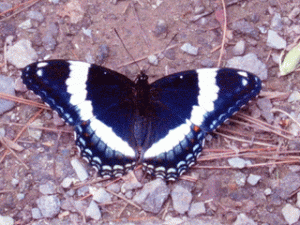
Great spangled fritillary feasting on a marigold
Maraleen’s Butterfly Garden Tour, Summer 2006
